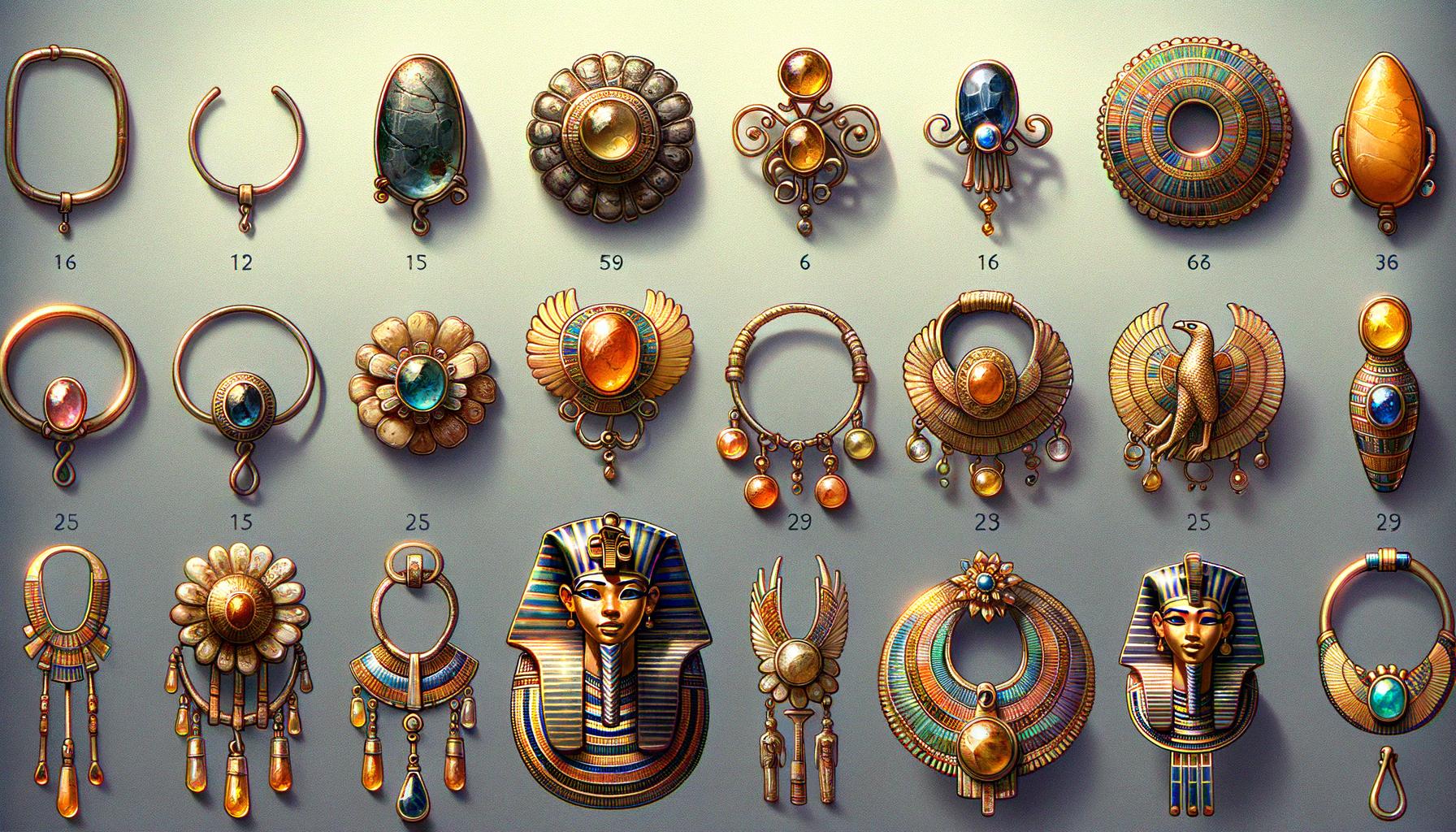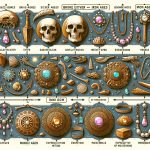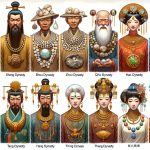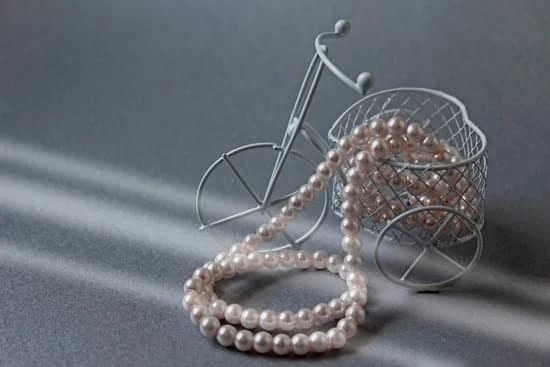The evolution of jewelry in ancient Egypt is a captivating journey through the eons, revealing not only the aesthetic inclinations of one of history’s most remarkable civilizations but also their spiritual and social framework. Ancient Egyptian society placed immense significance on jewelry, seeing it as far more than mere adornment.
Jewelry was intertwined with personal identity, social status, religious beliefs, and even the afterlife. From everyday citizens to royalty, intricate pieces adorned bodies both living and deceased, believed to offer protection, denote wealth, or serve as offerings to deities.
Egypt’s historical timeline is marked by several distinctive periods that saw transformations in craftsmanship and style. The Pre-Dynastic Period laid the foundational practices for subsequent eras with its use of readily available materials such as bones, stones, and shells.
As we traverse through time, moving from the grandeur of the Old Kingdom-an era synonymous with the Age of Pyramids-to the artistry explosion during the Middle Kingdom and finally reaching the opulence of the New Kingdom’s Golden Age, each chapter reveals advancements in techniques and heightened symbolism.
Jewelry-making in ancient Egypt was an ongoing interplay between evolving artistry and constant themes rooted deeply in religious iconography. The pieces crafted were not just meant for earthly beauty but served purposes related to protection against evil forces, guidance in the afterlife, and reverence toward gods like Anubis or Horus.
This convergence of art and spirituality ensured that Egyptian jewelry remained a vital part of both daily life and sacred rituals across millennia-a legacy that continues to enchant historians and enthusiasts worldwide today.
Early Beginnings
The Pre-Dynastic Period of ancient Egypt marks the nascent stages of a civilization that would come to be known for its opulence and artistic achievements, including in the realm of jewelry. During this era, which dates back to approximately 5000-3100 BCE, the evolution of jewelry in ancient Egypt began with simple yet profound creations.
Early Egyptians utilized readily available materials such as bones, stones, and shells to craft rudimentary forms of adornment. These materials were not only plentiful but also held significant meaning, with different textures and colors likely symbolizing various aspects of life and death.
Primitive forms of necklaces, bracelets, and amulets from this period have been discovered in burial sites, indicating that even from an early age, jewelry was more than mere decoration; it had spiritual and protective functions. Necklaces were often made from strands of beads strung together using thread or animal sinew.
Beads themselves ranged from small polished stones to intricately carved pieces demonstrating an early mastery over crafting techniques. While these items might seem simplistic compared to later Egyptian art, they represent a foundational stage in the long journey toward more sophisticated designs.
Amulets are particularly notable from this period since they reveal how intertwined adornment was with religion and superstition even at this early stage. These small objects were typically worn around the neck or wrist and were believed to confer protection upon the wearer against evil spirits or illness.
The use of organic materials like bone not only speaks to resourcefulness but also suggests a symbolic connection between physical matter and metaphysical beliefs. Thus, while primitive in appearance by later standards, jewelry during the Pre-Dynastic Period laid essential groundwork for what would eventually become one of the most distinguished aspects of ancient Egyptian culture.
Old Kingdom
During the Old Kingdom, also known as the Age of Pyramids (c. 2686 – 2181 BCE), remarkable innovations in jewelry-making techniques emerged that significantly contributed to the evolution of jewelry in ancient Egypt. One notable advancement was the refinement of metallurgy, particularly with gold and copper.
Jewelers developed techniques such as cold hammering, casting, and soldering, which allowed them to create more intricate and durable pieces. The use of faience, a glass-like material made from quartz and sand, became prevalent for creating vibrant beads and amulets that mimicked precious stones.
Symbolism played a central role in the jewelry of this period. Many pieces were imbued with religious significance or were believed to possess protective qualities. For instance, amulets shaped like deities and sacred animals symbolized divine protection and favor from the gods.
Jewelry was often adorned with motifs such as ankhs (representing life), scarabs (symbolizing rebirth), and eye designs (such as the Eye of Horus for protection). These symbols not only reflected personal piety but also indicated the wearer’s social status and proximity to divine power.
Several notable examples of Old Kingdom jewelry have been discovered in burial sites within pyramids and mastabas (flat-roofed tombs). These finds include exquisite necklaces, bracelets, pectorals, and rings crafted from gold, silver, turquoise, carnelian, lapis lazuli, and other semi-precious stones.
The tomb of Queen Hetepheres I-mother of King Khufu who built the Great Pyramid at Giza-yielded an array of finely crafted jewelry that highlights both artistic skill and symbolic meaning infused into each piece. Such discoveries offer critical insights into how deeply intertwined wealth, religion, artistry, and social hierarchy were during this ancient epoch.
Middle Kingdom
During the Middle Kingdom, spanning from approximately 2050 to 1710 BCE, there was a significant evolution in the craftsmanship and materials used in ancient Egyptian jewelry. This period saw the introduction of new materials such as semi-precious stones, gold, and silver, which elevated the aesthetic and cultural value of their adornments. The increased availability of these precious materials was facilitated by improved mining techniques and trade routes, allowing artisans to experiment with more intricate designs.
The advancement in design during the Middle Kingdom is evident in several key artifacts discovered from this era. Artisans started to create highly detailed pieces that showcased not only their technical skills but also their creativity. Jewelry items from this period often featured elaborate beadwork, sophisticated motifs inspired by nature and mythology, and more advanced forms of metalworking like granulation and cloisonné. These designs were not merely decorative; they held deep symbolic meanings related to protection, status, and religious beliefs.
Several notable examples highlight the sophisticated artistry achieved during this time. For instance, tomb excavations have unearthed exquisite pectorals fashioned with gold and semi-precious stones like carnelian, turquoise, and lapis lazuli. These pectorals often depicted scenes of divine significance or motifs such as scarabs that symbolized rebirth and protection.
Additionally, beautifully crafted bracelets adorned with detailed engravings served both as status symbols and protective amulets for the wearer. The evolution of jewelry in ancient Egypt during the Middle Kingdom truly marks a flourishing phase where artistry met functionality seamlessly.
Artifacts from this period typically included:
- Elaborate bead necklaces made from semi-precious stones.
- Pectorals decorated with symbolic images crafted in gold.
- Bracelets featuring intricate engravings and gems.
These finds underscore how jewelry transcended mere ornamentation to become an integral part of spiritual and daily life in ancient Egypt.
New Kingdom
Extravagance and Wealth
During the New Kingdom, ancient Egypt witnessed an unprecedented era of wealth and prosperity, which naturally extended to their jewelry. This period is often referred to as the “Golden Age” due to the extensive use of gold in ornaments and decorations.
The Gold Mines of Nubia supplied vast quantities of this precious metal, allowing artisans to indulge in creating elaborate jewelry pieces. Such extravagance was not limited to royalty; even nobility and high-ranking officials adorned themselves with intricate necklaces, bracelets, earrings, and rings made from gold encrusted with semi-precious stones like lapis lazuli, carnelian, and turquoise.
Royal Influence
Pharaohs such as Tutankhamun had a significant influence on jewelry trends during this period. The young king’s tomb revealed a treasure trove of exquisite jewelry that highlighted the meticulous craftsmanship of Egyptian goldsmiths. These items included pectorals, diadems, and amulets adorned with hieroglyphics and symbology intended both for beauty and protection in the afterlife. The evolution of jewelry in ancient Egypt reached its zenith during Tutankhamun’s reign, showcasing designs that would influence generations to come.
Spiritual and Protective Qualities
Amidst the opulence of this era, spiritual significance remained paramount in Egyptian jewelry design. Amulets were commonly embedded within various types of jewelry for their protective qualities. Symbols like the Eye of Horus were believed to ward off evil forces while ensuring safety and good health.
Scarabs signified regeneration and transformation, offering spiritual protection both in life and death. This synthesis of aesthetic beauty with profound religious meaning underscored how deeply intertwined spirituality was with daily life in ancient Egypt despite-or perhaps because of-the kingdom’s immense wealth during its Golden Age.
The Role of Religion and Mythology
Gods and Goddesses
In ancient Egyptian society, religion was deeply intertwined with daily life, politics, and culture. Jewelry played a significant role in this religious framework as it often embodied the power, protection, and blessings of various deities. The omnipresent symbols of gods and goddesses were artistically woven into amulets, necklaces, rings, and other adornments.
For example, Isis, the goddess of magic and motherhood, was a prevalent figure in jewelry motifs. Artifacts often featured her likeness or symbolic representations such as the ankh or the tyet knot.
Osiris, the god of the afterlife and rebirth, appeared frequently in funerary jewelry designed to safeguard travelers on their journey to the underworld. Amulets crafted in his image or bearing his symbols served not just as decorative pieces but as powerful spiritual tools intended to ensure safe passage and eternal life. Additionally, Hathor-known for her association with fertility and music-was another popular deity featured in various forms of jewelry.
Mythological Motifs
Mythological motifs were integral to the evolution of jewelry in ancient Egypt. One potent symbol was the Eye of Horus, also known as the Wedjat eye. This emblem symbolized protection, health, and restoration; thus, it found its way into numerous amulets worn by Egyptians from all strata of society. Fashioned from materials like turquoise or lapis lazuli for their perceived protective qualities, these amulets were prized possessions believed to ward off evil spirits.
Another common mythological element was the scarab beetle which represented transformation and rebirth. Scarabs were made into rings or worn as pendants believed to help revitalize both body and spirit during one’s lifetime while also serving as carriers that could secure passage through trials faced in the afterlife. Moreover, certain pieces integrated metallic gold with intricate carvings depicting Anubis-the god associated with mummification-as a further invocation for protection against malevolent forces.
Spiritual Properties
Jewelry in ancient Egypt was far more than mere ornamentation; it possessed deeply spiritual properties that aligned closely with religious beliefs and customs. Amulets formed a crucial part of burial practices; they were placed within mummy wrappings or worn by figures depicted on tomb walls to ensure that magical energies protected both body and soul throughout eternity. Specific stones like carnelian or faience were chosen deliberately for their reputed mystical attributes linked to strength or healing.
For instance, heart scarabs inscribed with spells from the Book of the Dead played an essential role during judgment before Osiris-they weighed one’s heart against Ma’at’s feather representing truth. Such jewelry pieces illustrate how intricately faith interwove into daily existence: blending purposefully designed aesthetics with profound divine significance imbued through centuries-old traditions kept alive by skilled artisans dedicatedly crafting these relics using their advanced techniques accumulated over generations.
The Social and Economic Impact
The evolution of jewelry in ancient Egypt had a profound social and economic impact on society, reflecting not only status and wealth but also the intricate organization of craftsmen and workshops. Craftsmen specializing in jewelry were highly regarded, often working under the patronage of pharaohs and high-ranking officials. These artisans operated within well-structured workshops that were integral to the economy, focusing on producing intricate pieces that ranged from everyday wear to elaborate ceremonial artifacts.
Workshops in ancient Egypt were bustling centers of creativity and commerce, employing a variety of skilled workers including gem cutters, metalworkers, bead makers, and designers. The division of labor within these workshops allowed for specialization and efficiency in crafting high-quality pieces.
Discoveries from archeological sites reveal detailed records that indicate a systemized approach to jewelry-making; some workshops appear to have been state-run enterprises focused on meeting the demands of the elite class. This dynamic highlights how the production of jewelry was more than an art form-it was a significant industry driving economic activity.
Moreover, trade played an essential role in the availability of precious materials used for creating Egyptian jewelry. The Egyptians engaged in extensive trade networks reaching as far as the Near East and sub-Saharan Africa to procure gold, lapis lazuli, turquoise, carnelian, and other valued resources. This exchange facilitated not only the importation of raw materials but also cultural influences that would occasionally be reflected in design elements. For instance:
- Gold sourced from Nubia: Known as “the land of gold,” Nubia provided abundant resources critical for creating luxurious items.
- Lapis Lazuli from Afghanistan: Valued for its deep blue color, it was frequently imported through complex trade routes.
- Turquoise: Mined locally from Sinai Peninsula quarries.
In this way, trade bolstered both the economy and artistic expression within ancient Egypt, enhancing its capacity to produce breathtaking ornaments that served various social functions-from denoting rank to protecting spiritual well-being.
The Legacy of Egyptian Jewelry
The influence of ancient Egyptian jewelry did not merely end with the fall of their civilization; it rippled through history, shaping subsequent cultures in significant ways. The intricate techniques and designs pioneered by ancient Egyptian artisans were adopted and adapted by the Greeks, Romans, and even later civilizations.
For instance, the use of gold filigree-a complex form of decorative work using fine gold wires that was perfected by the Egyptians-found its way into Roman jewelry design. These enduring techniques are a testament to the evolutionary prowess seen throughout various periods such as the Old Kingdom, Middle Kingdom, and New Kingdom.
Modern-day discoveries continue to unearth treasures that provide deeper insights into the evolution of jewelry in ancient Egypt. The tomb of Tutankhamun remains one of the most significant finds, with its wealth of exquisite pieces providing unparalleled examples of craftsmanship from the New Kingdom’s Golden Age.
Recent excavations have also unveiled lesser-known burial sites that contain equally impressive artifacts, further enriching our understanding of ancient Egyptian art and culture. Each new find is cataloged meticulously and often becomes a focal point for extensive research within academic circles.
Today’s museums worldwide host numerous exhibitions displaying these masterpieces, attracting millions who marvel at their beauty and historical significance. Institutions such as the British Museum in London and the Egyptian Museum in Cairo offer extensive collections where visitors can immerse themselves in ancient Egyptian culture. These exhibitions serve as a bridge connecting modern society with its ancient past, illustrating how deeply ingrained the evolution of jewelry in ancient Egypt is in our cultural heritage.
| Museum | Notable Exhibits |
|---|---|
| British Museum, London | Tutankhamun’s Treasures |
| Egyptian Museum, Cairo | Jewelry from Pharaohs’ Tombs |
Conclusion
The evolution of jewelry in ancient Egypt marks a fascinating journey steeped in religious, social, and economic significance. From the rudimentary materials used during the Pre-Dynastic Period to the intricate gold and gemstone creations of the New Kingdom, each phase showcases the creative ingenuity and cultural priorities of its time.
Jewelry was not merely for adornment; it symbolized power, served as protective amulets, and connected the wearers with their gods. The craftsmanship required was both an art form and a profession that supported local economies through trade with neighboring regions.
Artisans played a crucial role within this societal fabric. These skilled craftsmen developed innovative techniques that allowed for more sophisticated designs. Workshops specialized in different stages of jewelry production-from goldsmithing to stone carving-highlighting a well-organized industry. Excavations have unearthed artifacts that illustrate these advancements, such as elaborate necklaces found in royal tombs or intricately carved scarabs showing both high technical skill and deep symbolic meaning.
Moreover, ancient Egyptian jewelry had far-reaching influences beyond its borders. Items like ankhs and scarab motifs crossed into Mediterranean cultures through trade and conquest, thereby shaping artistic expressions in Greek, Roman, and other contemporary civilizations. Today’s museums worldwide continue to exhibit these magnificent pieces, allowing modern audiences to appreciate not just their aesthetic beauty but also their historical contexts.
| Aspect | Details |
|---|---|
| Materials Used | Bones, stones, shells (early periods); semi-precious stones, gold (later periods) |
| Symbolism | Power symbols (crowns), protective amulets (Eye of Horus), religious connections |
| Cultural Impact | Influenced Greek and Roman arts & fashion through trade |
Understanding the evolution of jewelry in ancient Egypt offers valuable insights into a civilization renowned for its architectural marvels and rich cultural tapestry. As we continue to discover new artifacts through archeological endeavors, our appreciation for their intricate artistry and profound meanings only deepens.
Further Reading and Resources
In conclusion, the evolution of jewelry in ancient Egypt is a fascinating journey through time that reveals much about the culture, beliefs, and technological advancements of this remarkable civilization. From the rudimentary use of bones and shells in the Pre-Dynastic Period to the sophisticated gold and gemstone creations of the New Kingdom, each era showcases an increasing complexity in craftsmanship and design.
Jewelry was not merely decorative; it held profound symbolic meaning, connected closely with religion, mythology, and social status.
Throughout various periods such as the Old Kingdom’s age of pyramids and the Middle Kingdom’s flourishing artistry, we see how innovations in materials and techniques led to ever more elaborate pieces. The New Kingdom stands out for its sheer extravagance, influenced significantly by royal patronage from pharaohs like Tutankhamun.
Jewelry served both spiritual and protective purposes, from amulets invoking divine favor to symbols carrying rich mythological significance. Themes like the Eye of Horus and scarabs exemplify how jewelry functioned as a bridge between the earthly realm and the divine.
The legacy of Egyptian jewelry extends far beyond its historical origins. It has shaped artistic expressions across subsequent civilizations and continues to inspire modern designs. The continued fascination with ancient Egyptian jewelry lies not only in its intricate beauty but also in its ability to tell stories about an advanced society that thrived millennia ago. This blend of artistry, spirituality, and history ensures that ancient Egyptian jewelry endures as a subject of scholarly intrigue and public admiration alike.
For those yearning to delve deeper into this captivating topic, there is a wealth of resources available-from scholarly books to museum exhibits-offering further insights into one of humanity’s earliest expressions of craft and culture.
Frequently Asked Questions
What Is the History of Jewelry in Egypt?
The history of jewelry in Egypt dates back to before 3000 BCE, with artworks and remains showcasing its significance in the daily lives and afterlife beliefs of ancient Egyptians. Jewelry was not only an adornment but also a symbol of status and spirituality. Pharaohs, nobles, and even common people wore a variety of ornaments made from precious metals and stones.
Gold was particularly esteemed for its incorruptibility, symbolizing eternity. Amulets were commonly incorporated into pieces to provide protection from evil spirits and bring good fortune.
What Was the Technique of Making Egyptian Jewelry?
The technique of making Egyptian jewelry combined meticulous craftsmanship with the use of a wide array of materials, including gold, silver, copper, semi-precious stones like turquoise, carnelian, and lapis lazuli, as well as glass and faience (a type of glazed ceramic). Artisans employed methods such as filigree (delicate metalwork) and granulation (tiny beads fused to the surface), along with techniques for inlaying stones into carved settings.
Tools made from stone or bronze were used to cut and shape the materials; then heat treatments helped set them into intricate designs that often held symbolic meaning.
What Was the Most Popular Jewelry in Ancient Egypt?
Among the most popular types of jewelry in Ancient Egypt were amulets, broad collars known as “wesekhs,” rings, earrings, bracelets, anklets, diadems, belts adorned with pendants called “girdle ties,” and pectorals worn across the chest. The scarab beetle amulet was exceptionally favored due to its association with rebirth and protection in both life and death contexts.
Additionally, collars made from multiple rows of beads were highly treasured by all classes for their decorative beauty as well as their religious significance related to gods like Hathor and Bastet.

Welcome to my jewelry blog! My name is Sarah and I am the owner of this blog.
I love making jewelry and sharing my creations with others.
So whether you’re someone who loves wearing jewelry yourself or simply enjoys learning about it, be sure to check out my blog for insightful posts on everything related to this exciting topic!





